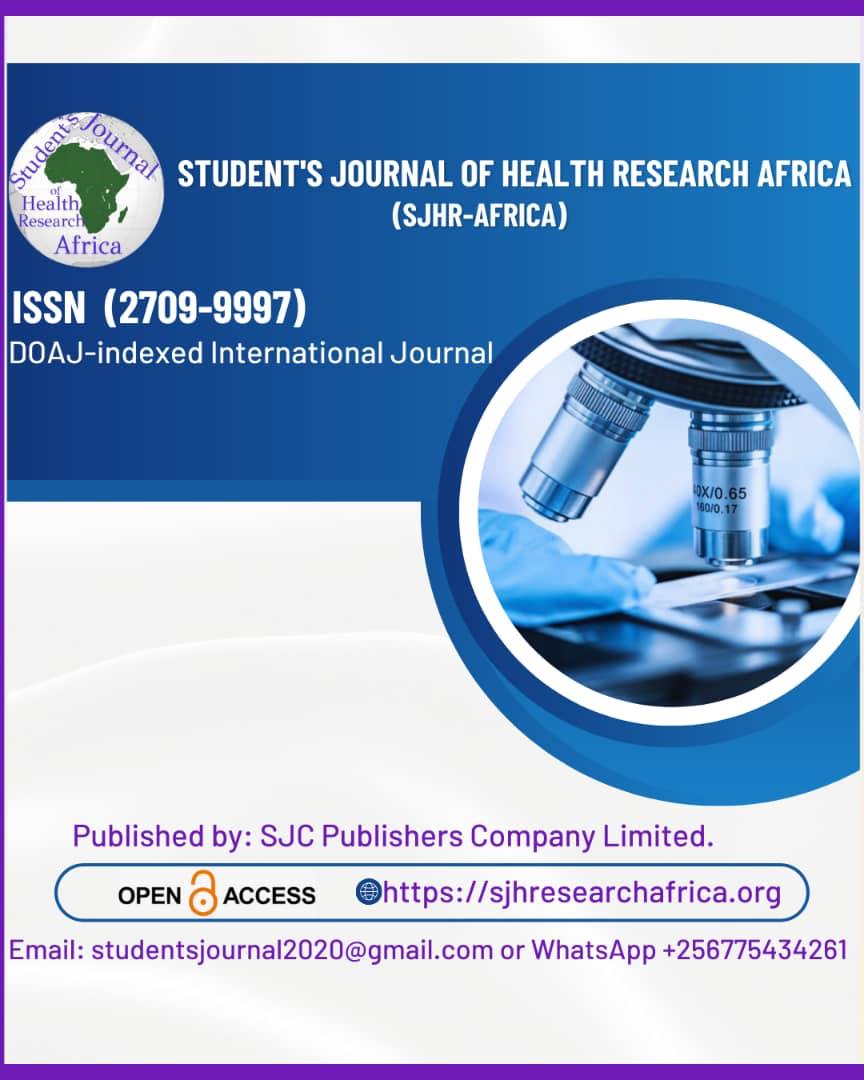Evaluation of urinary tract infections in patients admitted in an intensive care unit (ICU) at Inkosi Albert Luthuli central (IALCH) hospital in Kwazulu-Natal, Durban: A retrospective cross-sectional study designed to determine the most prevalent pathogens of urinary tract infections.
DOI:
https://doi.org/10.51168/sjhrafrica.v6i6.1574Keywords:
Urinary tract infections, Intensive care unit, Antimicrobial susceptibility, multiple drug resistanceAbstract
Background
Urinary tract infections are among the most prevalent diseases in patients admitted to the Intensive Care Unit (ICU). ICU patients are at higher risk for UTIs due to factors such as indwelling urinary catheters, prolonged hospital stay, antibiotic use, immunocompromised, and underlying comorbidities like diabetes.
Aim
To identify the most prevalent isolated microorganisms causing UTIs in ICU patients with UTIs. To Assess Antimicrobial Susceptibility Patterns of isolated microorganisms. To analyse demographic information of patients with UTIs.
Methodology
This project was a retrospective quantitative study that looked at ICU patients admitted to IALCH. The study was a convenience non-probability study, which was done in an NHLS microbiology laboratory using standard urine culture and a VITEk-2 automated system.
Results
270 positive urine specimens, the most common isolate was Escherichia coli (n=143; 53%), followed by Klebsiella pneumoniae subsp (n=40; 14.8%). Enterococcus faecalis (n=16; 6.0%) was the most common Gram-positive pathogen. E. coli showed significant resistance to Cefotaxime, ceftriaxone (31.4%), Gentamycin (10.4%), cefepime (6.3%) ,and piperacillin-tazobactam (3.5%). Among Gram-positive, E. faecalis showed 75% susceptibility.
Conclusion
E. coli was the most common isolate, accounting for 53% followed by Klebsiella pneumoniae subspp and E. faecalis in ICU patients admitted to IALCH. Notably, E. coli exhibited significant resistance to multiple antibiotics, including cefotaxim, ceftriaxone, gentamycin, cefepime, and piperacillin. In contrast, E. faecalis demonstrated 75% susceptibility to the tested antibiotics. E. faecalis was also most prevalent among the gram-positive, accounting for 6.0%. Vancomycin was found to be the most effective for E. faecalis. Ciprofloxacin was found to be the least effective, with a high rate of resistance for E. faecalis. This study also discovered that UTIs were more common in patients between the ages of 40-65 years, and the study showed that the most affected were females.
Recommendations
Future research should prioritize comprehensive data collection methods.
References
Atkins L, Sallis A, Chadborn T, Shaw K, Schneider A, Hopkins S, Bunten A, Michie S, Lorencatto F, 2020, Reducing catheter-associated urinary tract infections: a systematic review of barriers and facilitators and strategic behavioural analysis of interventions. Implementation Sci, 15, 44, available from: https://doi.org/10.1186/s13012-020-01001-2
Barchitta M, Maugeri A, Favara G, Riela PM, Mastra, Rosa MC, Gallo G, Mura I, Agodi A, 2021, Cluster analysis identifies patients at risk of catheter-associated urinary tract infections in intensive care units: findings from the SPIN-UTI Network. Journal of Hospital Infection. 107, pg.57-63 available from: https://doi.org/10.1016/j.jhin.2020.09.030
Bitew A, Zena N, Abdeta A, 2022. Bacterial and fungal profile, antibiotic susceptibility patterns of bacterial pathogens and associated risk factors of urinary tract infection among symptomatic paediatrics, infection and drug resistance, 1613-1624
Bizuayehu H, Bitew A, Abdeta A, Ebrahim S, (2022) Catheter-associated urinary tract infections in adult intensive care units at a selected tertiary hospital, Addis Ababa, Ethiopia. PLOS ONE 17(3): e0265102 [online] Available from: https://doi.org/10.1371/journal.pone.0265102.
Burrows LL, 2024. It`s uncomplicated: Preventions of urinary tract infections in an era of increasing antibiotic resistance. PLos Pathog, 20(2): e1011930. Available from: https://doi.org/10..1371/journal.ppat.1011930
CDC, 2024. Urinary Tract Infections (Catheter-Associated Urinary Tract Infection [CAUTI] and non-Catheter-Associated Urinary Tract Infection [UTI]) Events, NHSN.
Clarke, K, Hall, CL, Wiley, Z, Tejedor, SC, Kim, JS, Reif, L, Witt, L, & Jacob, JT, 2020. Catheter-Associated Urinary Tract Infections in Adults: Diagnosis, Treatment, and Prevention. Journal of hospital medicine,15(9), pp. 552–556.
Cournant A, 2022. Complicated UTI, Infectious Disease ADVISOR, available from: https://www.infectiosdiseaseadvisor.com/ddi/complicated-uti/
Dadi, B.R., Abebe, T., Zhang, L., Mihret, A., Abebe, W. and Amogne, W., 2020. Distribution of virulence genes and phylogenetics of uropathogenic Escherichia coli among urinary tract infection patients in Addis Ababa, Ethiopia. BMC infectious diseases, 20, pp.1-12.
Duszynska W, Rosenthal VD, Szczesny A, Zajaczkowska K, Fulek M, Tomaszewski J,2020, Device associated -health care associated infections monitoring, prevention and cost assessment at intensive care unit of University Hospital in Poland (2015-2017). BMC Infect Dis 20, 761, available from: https: //doi.org/10.1186/s12879-020-05482-w
Florence-Mireles A, Hreha TN, Hunstad DA, 2019, Pathophysiology, Treatment, and Prevention of Catheter-Associated Urinary Tract Infection. Top spinal Cord Inj Rehabil, 25(3) pg. 228-240, available from: https://doi.org/10.1310/sci2503-228
Gurnadi WD, Karuniawati A, Umbas R, Bardosono S, Lydia A, Soebandrio A, Safari D, 2021. Biofilm-Producing Bacteria and Risk Factors (Gender and Duration of Catheterization) Characterized as Catheter-Associated Biofilm Formation. International Journal of Microbiology, 2021(1) [online] Available: https://doi.org/10.1155/2021/8869275
Isigi SS, Parsa AD, Alasqah I, Mahmud I, Kabir R, 2023. Predisposing factor of nosocomial infections in hospitalized patients in the United Kingdom: systematic review, JMIR public health and surveillance, 9, e43743
Izadi N, Eshrati B, Mehrabi Y, Etemad K, Hashemi-Nazari S, 2020. The national rate of intensive care units-acquired infections, one – year retrospective study in Iran. BMC public health, 21(1), 1-8.
Kalın, G., Alp, E., Chouaikhi, A. and Roger, C., 2023. Antimicrobial multidrug resistance: clinical implications for infection management in critically ill patients. Microorganisms, 11(10), p.2575.
Kollef MH, Torres A, Shorr AF, Martin-loeches I, Micek SI,2021. Nosocomial infection: Critical care medicine, 42(2), pg. 169-187 [online] available: https://journals.lww.com/ccmjournal/abstract/2021/02000/Nosocomial _infection.2.aspx?context=featuredarticles& collectionid=3
Kranz J, Schmidt S, Wagenlehner F, Schneidewind L, 2020, Catheter-associated urinary tract infections in adult patients: Preventive strategies and treatment options. Deutsches Arzteblatt international, 117(6), pg. 83, available from: https://scholar.google.com/scholar?as_ylo=2019&q=catheter+associated+urinary+tract+infection&hl=en&as_sdt=0,5#d=gs_qabs&t=1700337382595&u=%23p%3DL01MoPO-8QgJ
Lopez MJ, Cortes JA, 2012. Urinary tract colonization and infection in critically ill patients, Med Intensiva, 36(2), p 143-151, available from: DOI: 10.1016/j.medine.2011.06.003
Mann R, Mediati DG, Duggin LG, Harry EJ, Bottomley AL, 2017, Metabolic Adaptations of Uropathogenic E. coli in the Urinary Tract. Frontiers in cellular and infection microbiology 7,241.
Mateescu, G.G., Idomir, M.E. and Nemet, C., 2014. Etiological and therapeutical particularities of urinary infections in urological patients. Bulletin of the Transilvania University of Brasov. Series VI: Medical Sciences, pp.19-24.
McDermott, H.M., 2016. The identification of the multi-drug-resistant organisms, vancomycin resistant enterococci (VRE) and extended spectrum β-lactamase producing Enterobacteriaceae (ESBL-E), in the ICU: examining the interplay between patient colonisation and environmental contamination (Doctoral dissertation, Royal College of Surgeons in Ireland).
Murtaugh, R, 2021. Nosocomial infections. In: critical care ,1St ed. New York: Routledge, p. 2. [online] available from: https: //doi.org/10.1201/9781315140629
Mythri, H. Kashinath, K.R. 2014. Nosocomial infections in patients admitted in intensive care unit of a tertiary health care center, India. Annals of medical and health sciences research, 4(5).
Nasrollahian, S., Graham, J.P. and Halaji, M., 2024. A review of the mechanisms that confer antibiotic resistance in pathotypes of E. coli. Frontiers in Cellular and Infection Microbiology, 14, p.1387497.
Naidoo, E.L., 2022. Assessing infection control knowledge and compliance in theatre at a private hospital in KwaZulu-Natal, South Africa (Doctoral dissertation).
Nicole LE, 2014, Catheter associated urinary tract infections. Antimicrob Resist Infect Control 3,23, available from: https://doi.org/10..1186/2047-2994-3-23
Oumer Y, Dadi B.R, Seid M, Biresaw G, Manila A, 2021, Catheter-Associated Urinary Tract Infection: incidence, associated Factors and Drug Resistance Patterns of Bacterial Isolated in Southern Ethiopia: NIH, 14, pg. 2883-2894 [online] available: https://www.ncbi.nlm.nih.gov/pmc/articles/PMC8318706/.
Patel Pk, Advani SD, Kofman AD, Lo E, Maragakis LL, Pegues DA, Pettis AM, Saint S, Trautner B, Yokoe DS, Meddings J, 2024. Strategies to prevent catheter associated urinary tract infections in acute-care hospitals, infect control Hosp Epidemiol, 44(8), 1209-1231, DOI:10.1017/ice.2023.137.
Pelling H, Nzakizwanayo J, Milo S, Denham EL, MacFarlane WM, Bock LJ, Sutton JM, Jones BV, 2019. Bacterial biofilm formation on indwelling urethral catheters. Letters in Applied Microbiology, 68(4), p 277-293, [online] available: https://doi.org/10.1111/lam.13144.
Perez, F., Endimiani, A., Ray, A.J., Decker, B.K., Wallace, C.J., Hujer, K.M., Ecker, D.J., Adams, M.D., Toltzis, P., Dul, M.J. and Windau, A., 2010. Carbapenem-resistant Acinetobacter baumannii and Klebsiella pneumoniae across a hospital system: impact of post-acute care facilities on dissemination. Journal of antimicrobial Chemotherapy, 65(8), pp.1807-1818
Perrin K., Vats, A., Qureshi, A. ,2021, Catheter-Associated Urinary Tract Infection (CAUTI) in the Neuro ICU: Identification of Risk Factors and Time-to-CAUTI Using a Case–Control Design. Neurocrit Care 34, 271–278, available from: https://doi.org/10.1007/s12028-020-01020-3
Pons, M.J. and Ruiz, J., 2019. Current trends in epidemiology and antimicrobial resistance in intensive care units. Journal of Emergency and Critical Care Medicine, 3.
Rubi H, Mudey G, Kunjalwar R, 2022. Catheter-associated urinary tract infection (CAUTI), Cureus 14(10).
Sabih A, Leslie SW, 2023. Complicated Urinary Tract Infections. StatPearls. available from: https//www.ncbi.nlm.nih.gov/books/NBK436013
Saleem M, Khaja ASS, Hossain A, Alenazi F, Said KB, Moursi SA, Almalaq HA, Mohamed H, Rakha E, Mishra SK, 2022, Catheter-Associated Urinary Tract Infection in Intensive Care Unit Patient at a Tertiary Care Hospital, Hail, Kingdom of Saudi Arabia.12(7), 1695; available from: https://doi.org/10.3390/diagnostics12071695
Sauer K, Stoodley P, Goeres DM, Hall-Stoodley L, Burmolle M, Stewart PS, Bjarnsholt T, 2022. The biofilm life cycle: expanding the biofilm formation. Nature reviews. Microbiology, 20(10), 608-620. Available from: https://doi.org/10.1038/s41579-022-00767-0
Schaffer JN, Pearson MM, 2015. Proteus mirabilis and Urinary Tract Infections. Microbiology spectrum, 3(5), 10.1128/microbiolspec.UTI-0017-2013. Available from: https://doi.org/10.1128/microbiolspec.UTI-0017-2013
Sikora A, Zahra F,2023. Nosocomial Infections, In: StatPearls [internet]. Treasure Island (FL) available from : https://www.ncbi.nlm.nih.gov/books/NBKS559312/
Ssekitoleko R.T, Oshabaheebwa S, Munal I G, Tusabe MS, Namayega C, Ngabirano B.A, Matovu B, Mugaga J, Reichert W.M, Joloba M.L, 2020, The role of medical equipment in the spread of nosocomial infections: a cross- sectional study in four tertiary public health facilities in Uganda: BMC, 20 [online] available: https:https://www.ncbi.nlm.nih.gov/pmc/articles/PMC7562759/#:~:text=This%2C%20combined%20with%20the%20fact,facilities%20in%20low%20resource%20settings.
Smith M, 2019. The prevalence of nosocomial infections in catheterized patients in the ICU. Journal of infectious Diseases, 50(3), 69-85.
Spadar, A., 2023. Understanding the genetic diversity, antimicrobial resistance, and virulence of Klebsiella pneumoniae bacteria (Doctoral dissertation, London School of Hygiene & Tropical Medicine).
Tajeddin E, Rashidan M, Razagh M, Javadi SS, Sherafat SJ, Alebouyeh M, Sarbazi M.R, Mansouri N, Zali M.R, 2016, The role of the intensive care unit environment and health care workers in the transmission of bacteria associated with hospital acquired infections: Journal of Infection and Public Health, 9(1), pg. 13-23[online] available: https://doi.org/10.1016/j.jiph.2015.05.010
Zhao A, Sun J, Liu Y, 2023, Understanding biofilms: from definition to treatment strategies. Available online: https: //doi/10.3389/fcib.2023.1137947: frontiers, 18
Downloads
Published
How to Cite
Issue
Section
License
Copyright (c) 2025 Nqobile Dlamini, Mr. S. Shangase

This work is licensed under a Creative Commons Attribution-NonCommercial-NoDerivatives 4.0 International License.






















